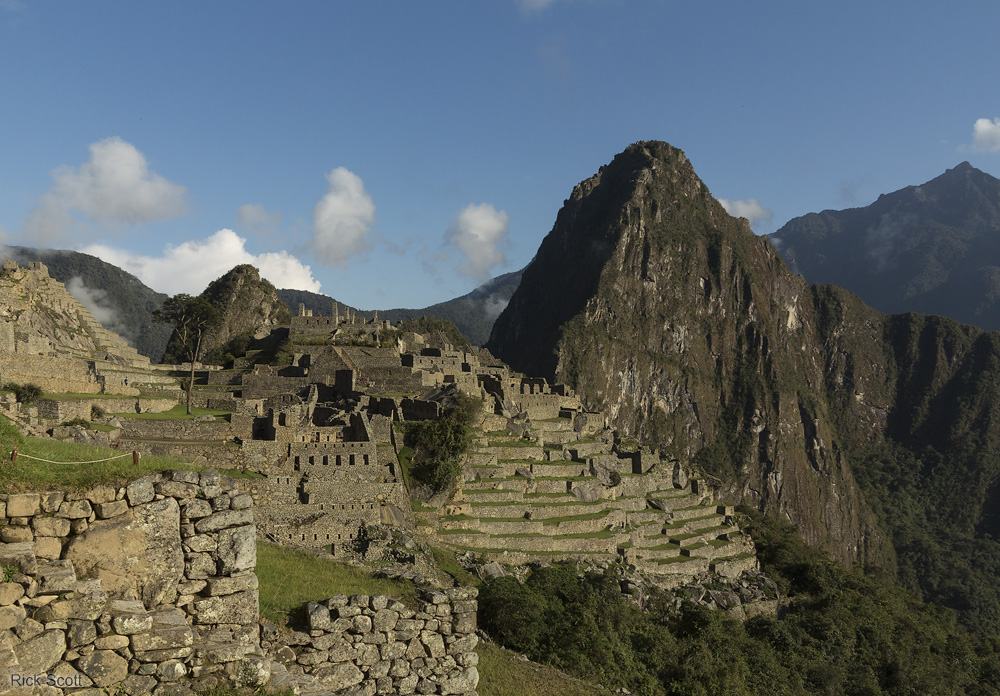
Machu Picchu from the agricultural terraces not far from the entrance. The large peak behind the right side of the ruins is Wayna Picchu.
Lens: Internal 15.1-60.4 mm, set to 15.1mm
Exposure: 1/400 second at f/8
Camera Mode: ISO 100 RAW
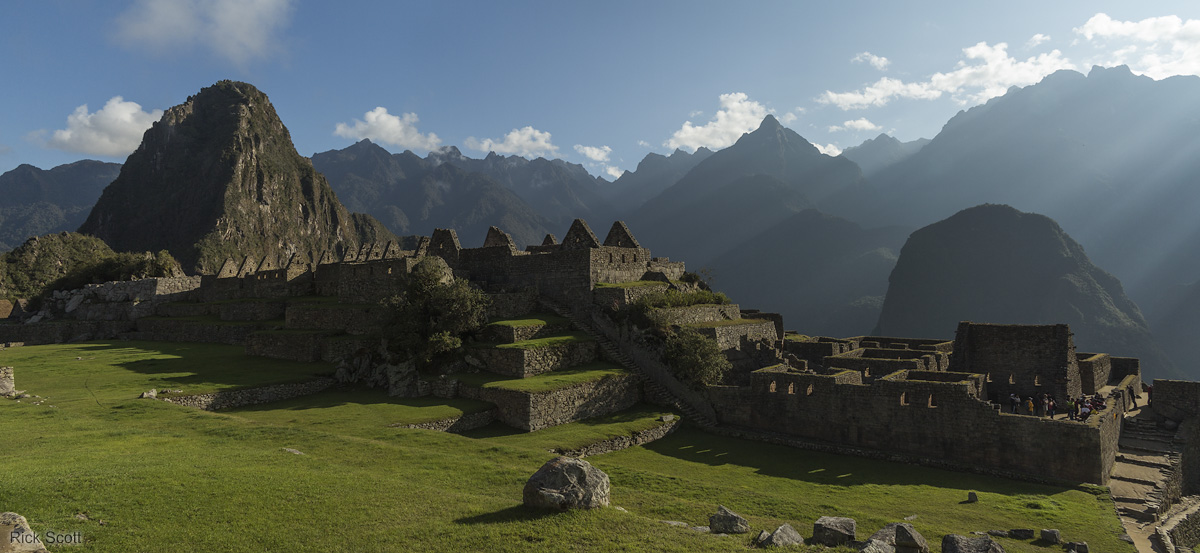
The residential section of Machu Picchu in early morning light. (2 image panorama)
Lens: Internal 15.1-60.4 mm, set to 15.1mm
Exposure: 1/400 second at f/8
Camera Mode: ISO 100 RAW
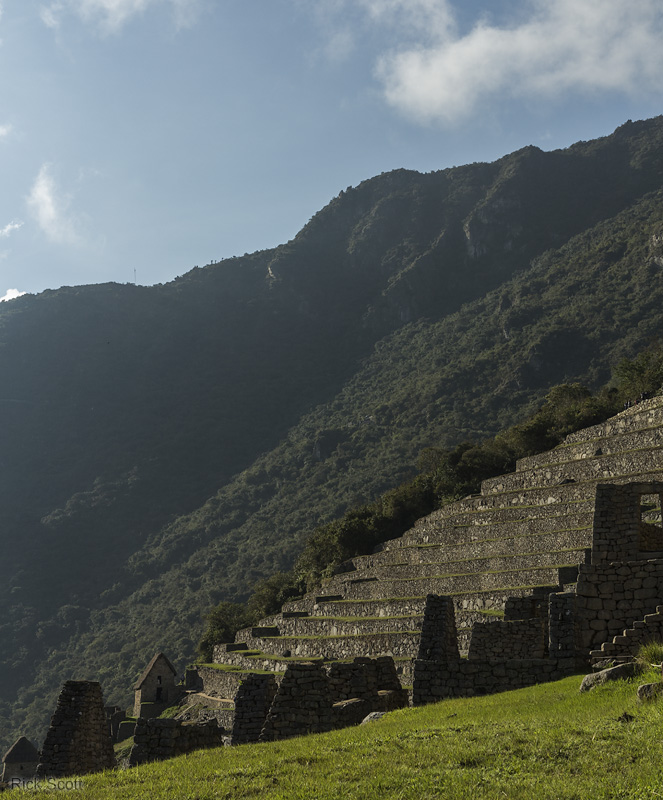
The agricultural terraces on the south end of Machu Picchu in early morning light.
Lens: Internal 15.1-60.4 mm, set to 31.4mm
Exposure: 1/320 second at f/8
Camera Mode: ISO 100 RAW
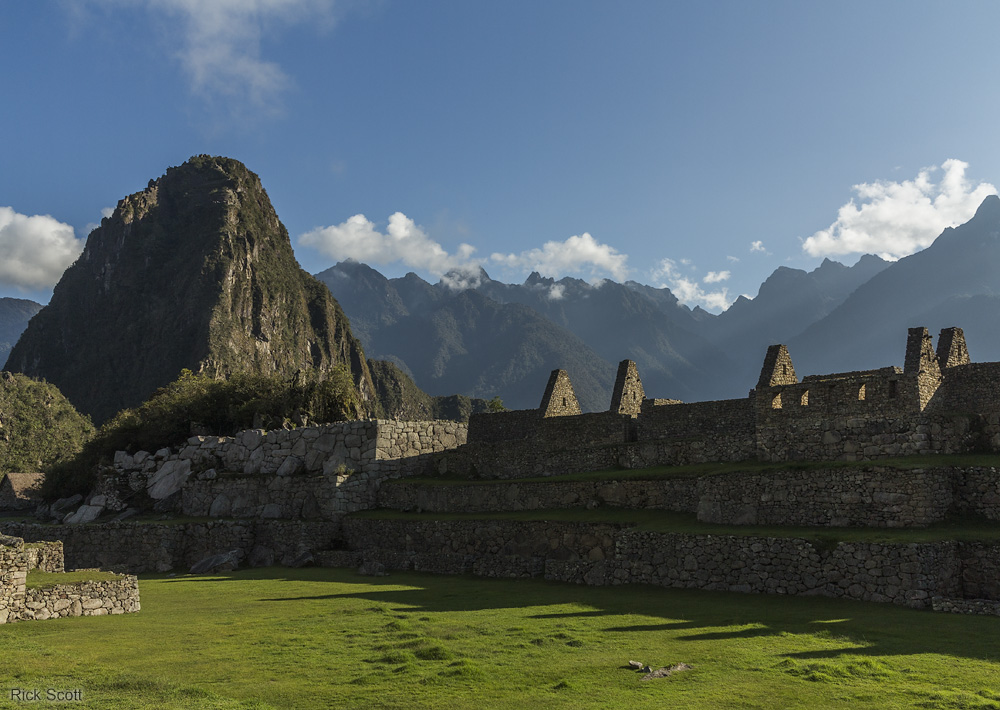
The residential section of Machu Picchu in early morning light.
Lens: Internal 15.1-60.4 mm, set to 18.6mm
Exposure: 1/320 second at f/8
Camera Mode: ISO 100 RAW
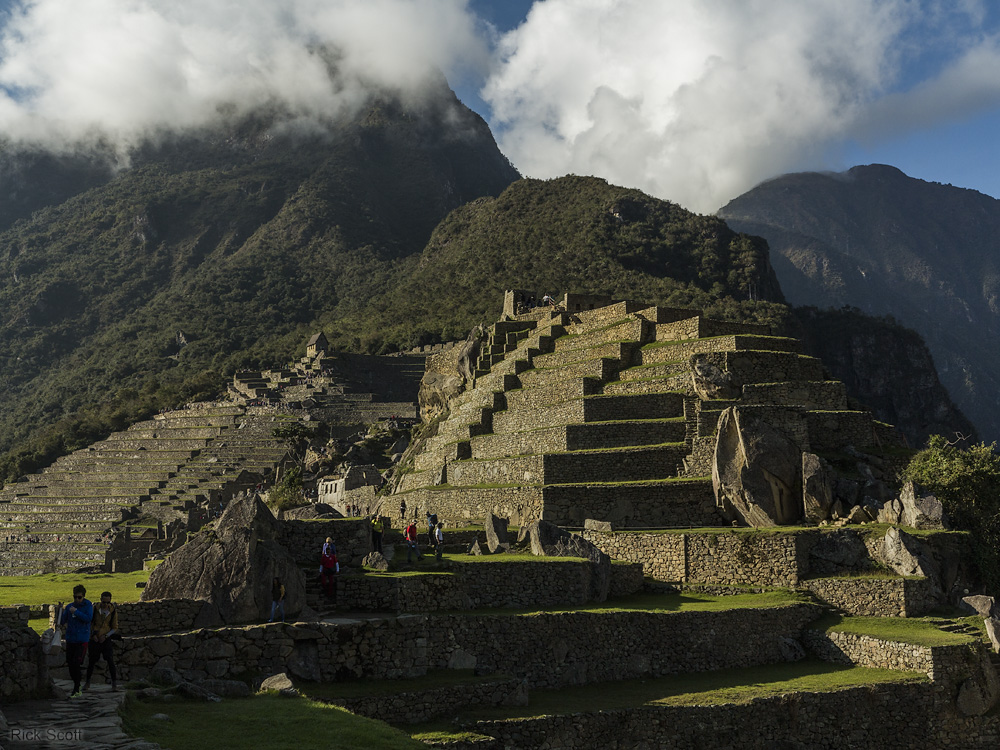
The religious section of Machu Picchu from near the north end of the ruins in early morning
light. To the lower left of center is the Temple of the Three Windows.
Lens: Internal 15.1-60.4 mm, set to 24.5mm
Exposure: 1/400 second at f/8
Camera Mode: ISO 100 RAW
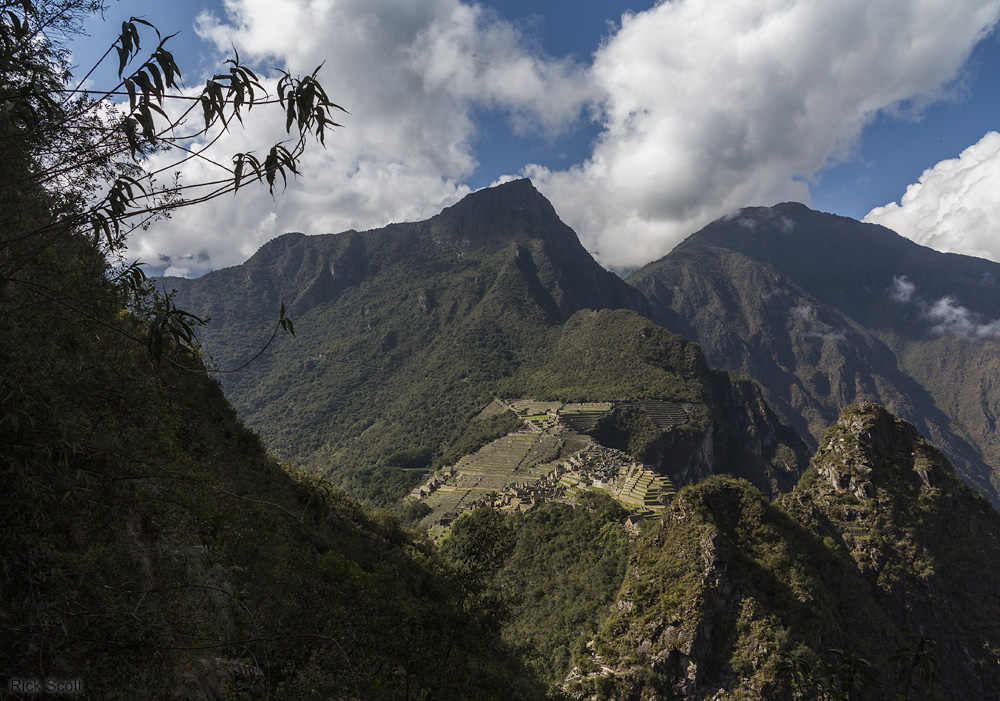
Machu Picchu from two-thirds of the way up Wayna Picchu.
Lens: Internal 15.1-60.4 mm, set to 15.1mm
Exposure: 1/400 second at f/8
Camera Mode: ISO 100 RAW
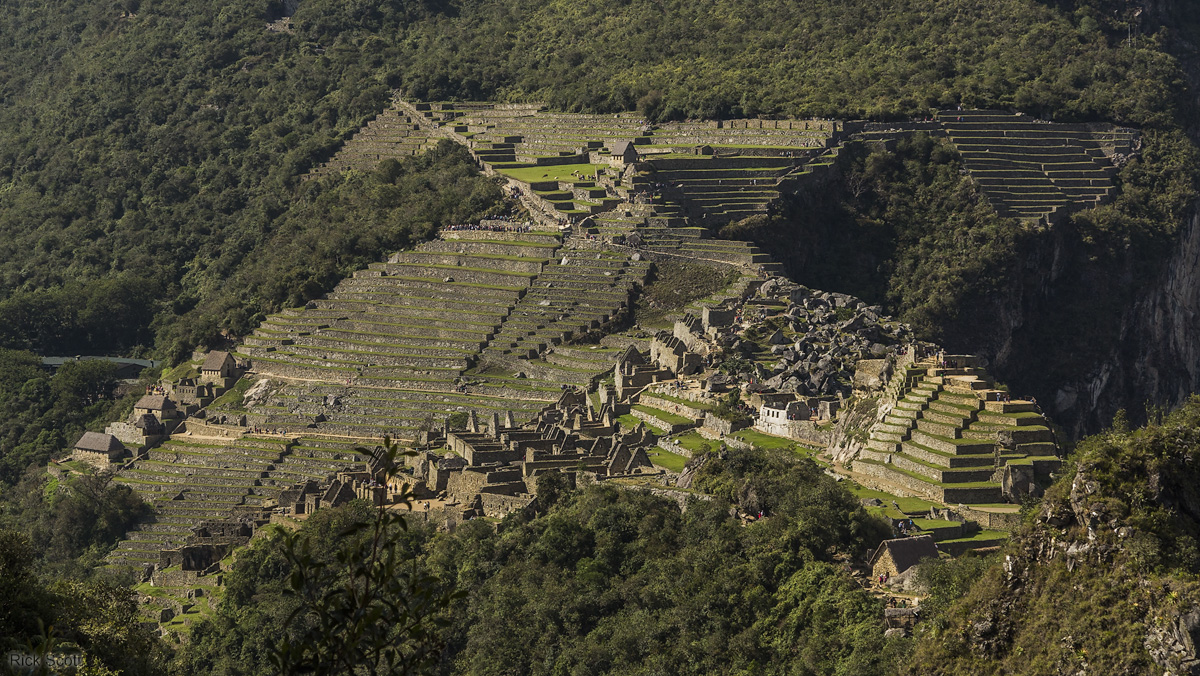
Telephoto view of Machu Picchu from two-thirds of the way up Wayna Picchu.
Lens: Internal 15.1-60.4 mm, set to 44.6mm
Exposure: 1/250 second at f/8
Camera Mode: ISO 100 RAW
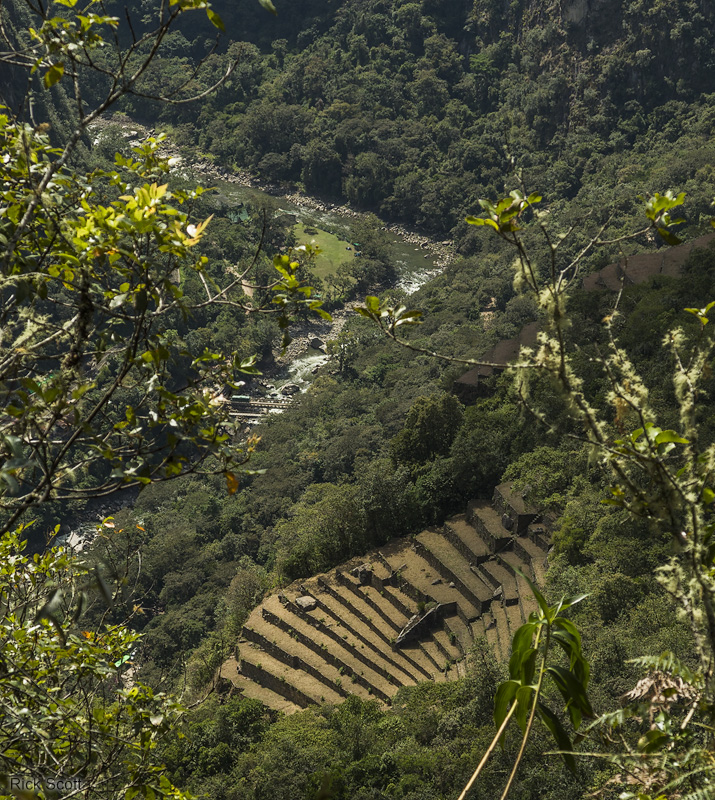
A small section of ruins and terraces located below the main Machu Picchu complex seen from the Wayna Picchu trail. The Urubamba River is in the background.
Lens: Internal 15.1-60.4 mm, set to 43.5mm
Exposure: 1/200 second at f/8
Camera Mode: ISO 100 RAW
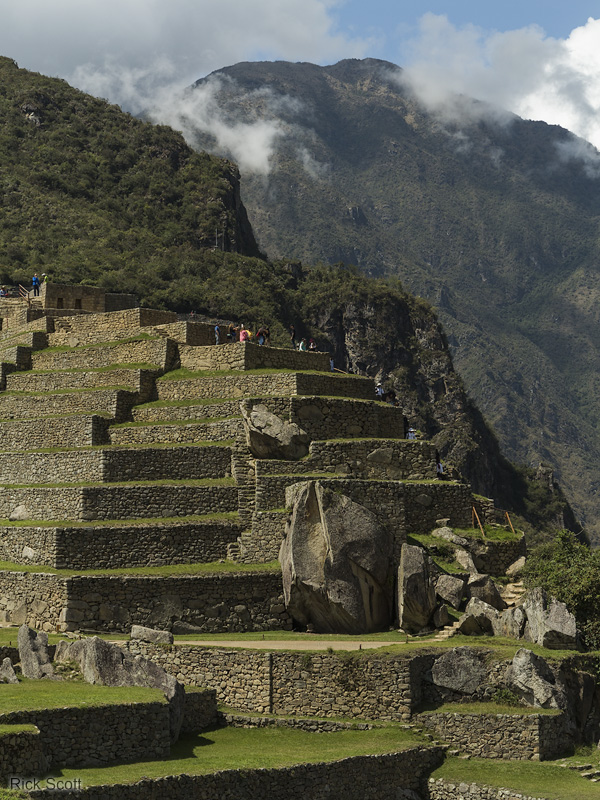
The terraces at the north end of the religious section of Machu Picchu below Intihuatana.
Lens: Internal 15.1-60.4 mm, set to 42.4mm
Exposure: 1/320 second at f/8
Camera Mode: ISO 100 RAW
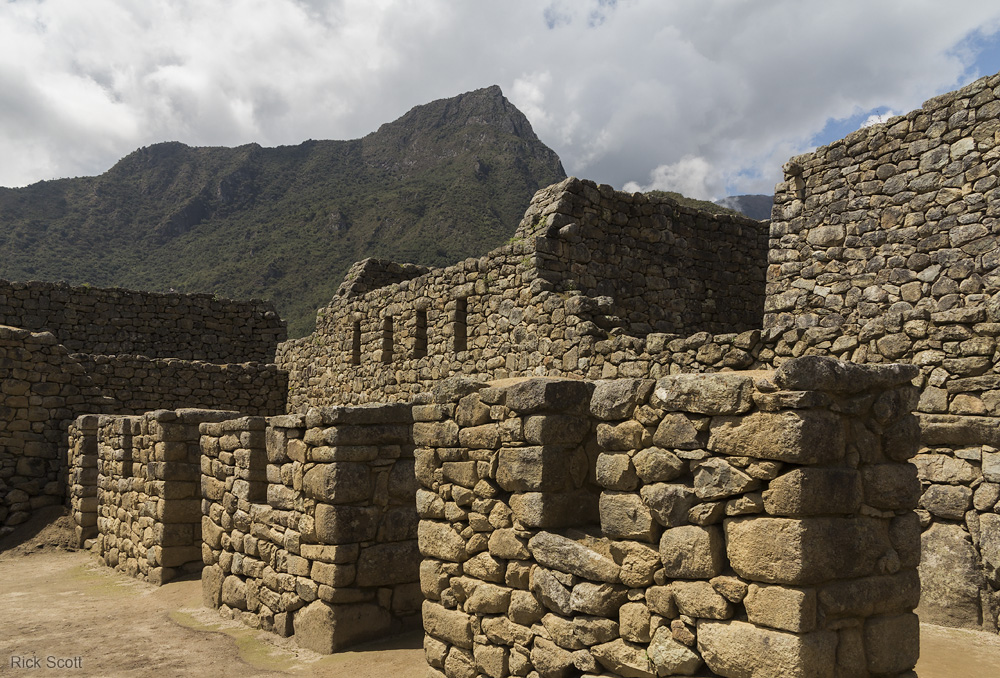
In the residential section of Machu Picchu.
Lens: Internal 15.1-60.4 mm, set to 15.1mm
Exposure: 1/320 second at f/8
Camera Mode: ISO 100 RAW
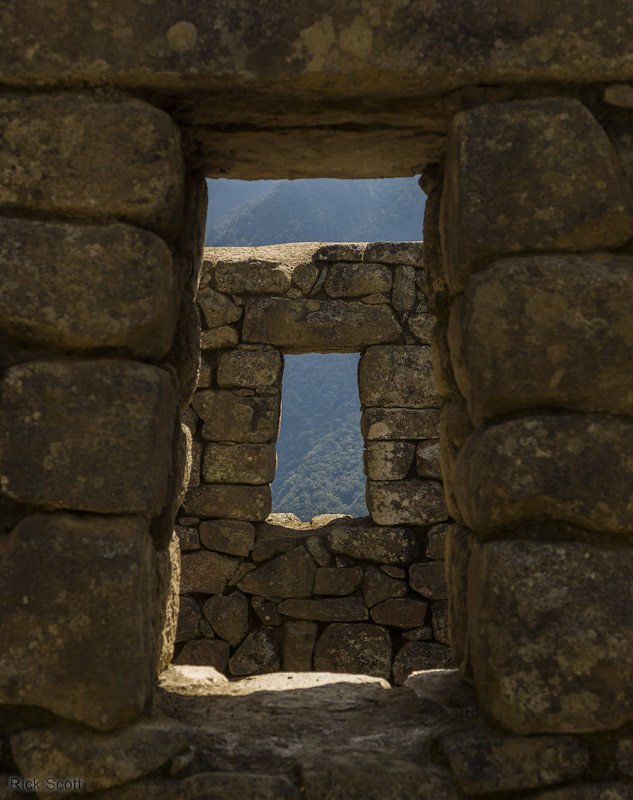
In the residential section of Machu Picchu.
Lens: Internal 15.1-60.4 mm, set to 35.8mm
Exposure: 1/160 second at f/8
Camera Mode: ISO 100 RAW
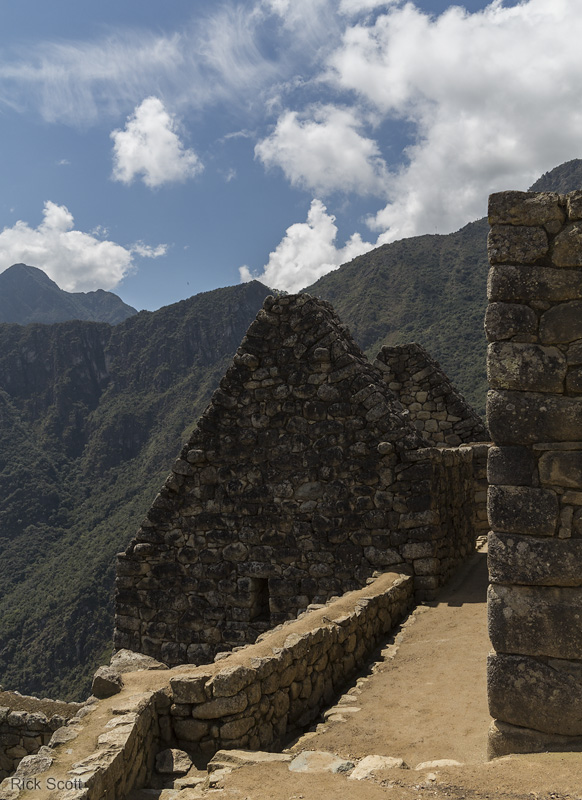
In the residential section of Machu Picchu.
Lens: Internal 15.1-60.4 mm, set to 16.3mm
Exposure: 1/400 second at f/8
Camera Mode: ISO 100 RAW
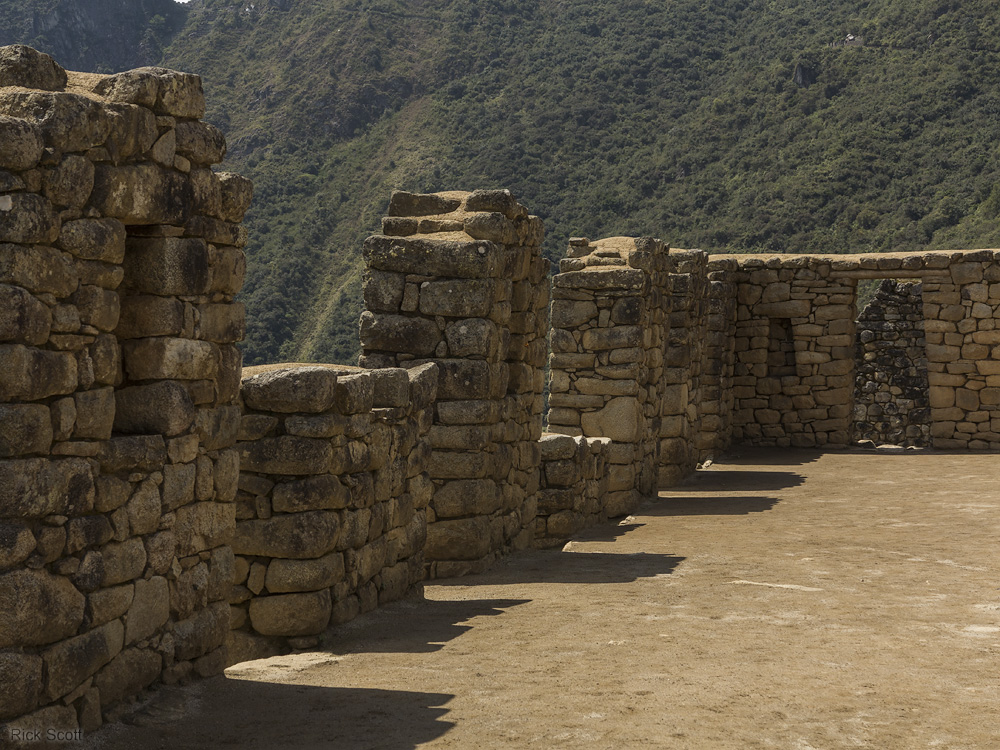
In the residential section of Machu Picchu.
Lens: Internal 15.1-60.4 mm, set to 33.0mm
Exposure: 1/250 second at f/8
Camera Mode: ISO 100 RAW
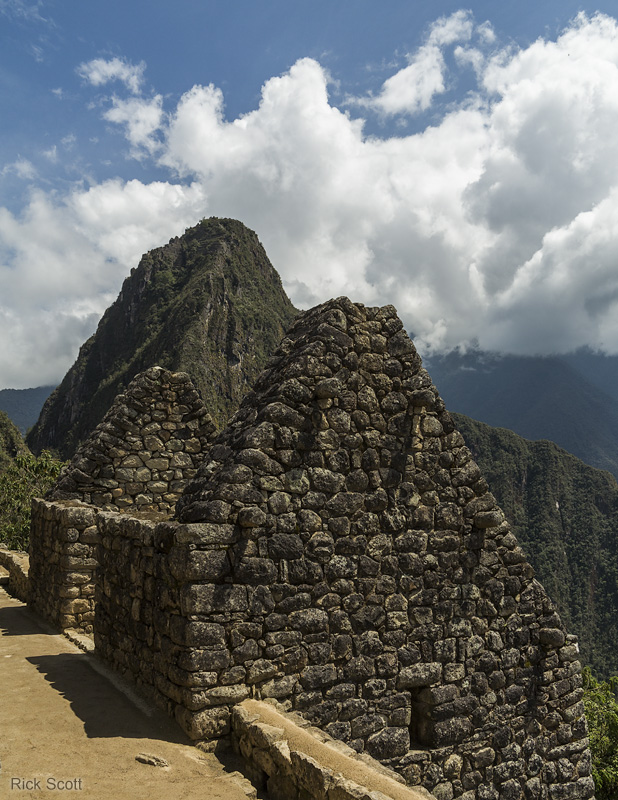
In the residential section of Machu Picchu. Notice how the roof lines mimic Wayna Picchu.
Lens: Internal 15.1-60.4 mm, set to 15.1mm
Exposure: 1/400 second at f/8
Camera Mode: ISO 100 RAW
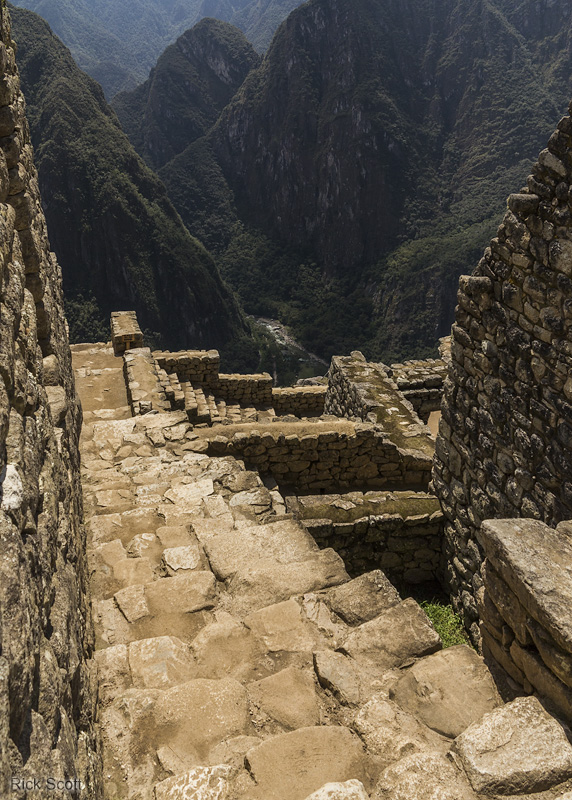
In the residential section of Machu Picchu. Looking down to the Urubamba River.
Lens: Internal 15.1-60.4 mm, set to 15.1mm
Exposure: 1/400 second at f/8
Camera Mode: ISO 100 RAW
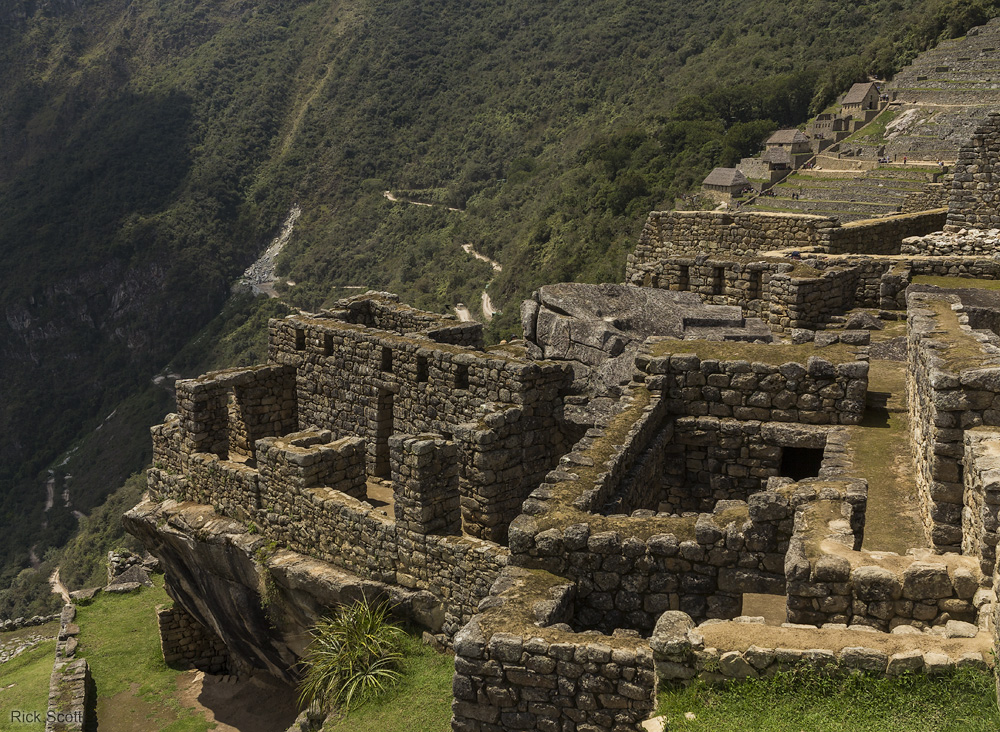
In the residential section of Machu Picchu.
Lens: Internal 15.1-60.4 mm, set to 19.2mm
Exposure: 1/320 second at f/8
Camera Mode: ISO 100 RAW
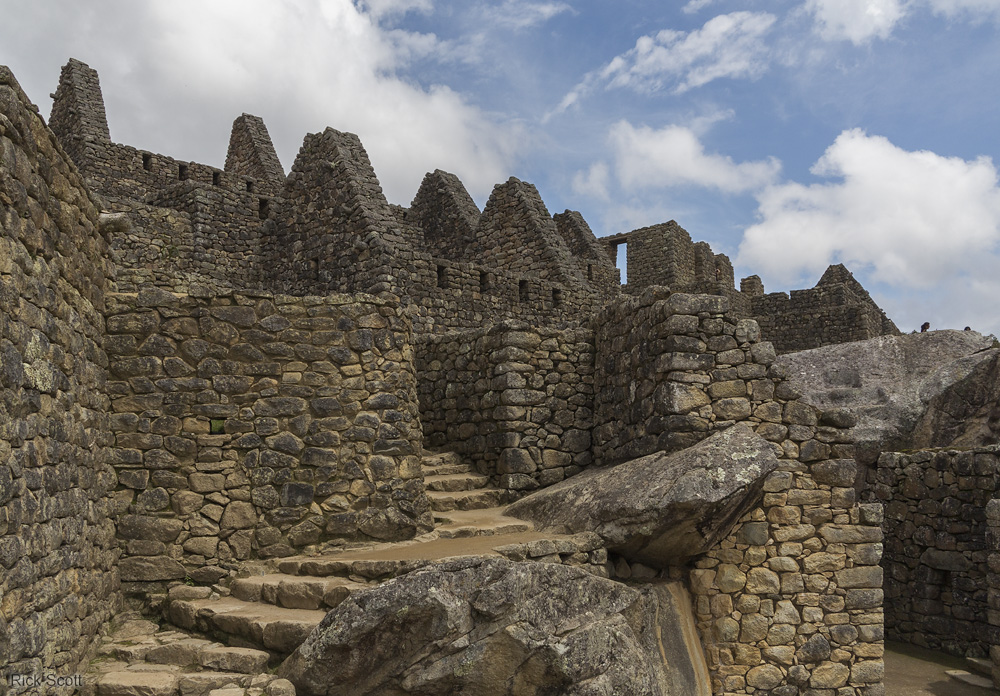
In the residential section of Machu Picchu.
Lens: Internal 15.1-60.4 mm, set to 15.1mm
Exposure: 1/400 second at f/8
Camera Mode: ISO 100 RAW
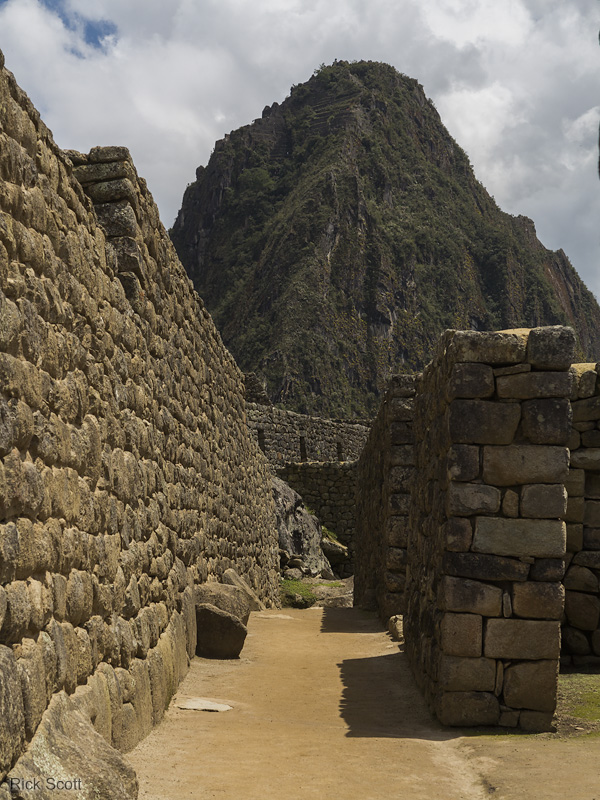
In the residential section of Machu Picchu with Wayna Picchu in the background.
Lens: Internal 15.1-60.4 mm, set to 36.3mm
Exposure: 1/400 second at f/8
Camera Mode: ISO 100 RAW
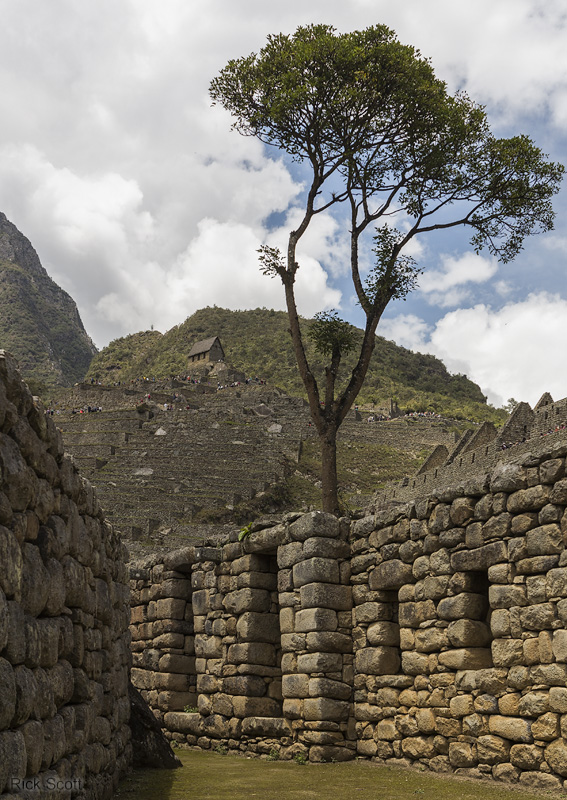
In the residential section of Machu Picchu looking up at the Gatehouse.
Lens: Internal 15.1-60.4 mm, set to 22.9mm
Exposure: 1/320 second at f/8
Camera Mode: ISO 100 RAW
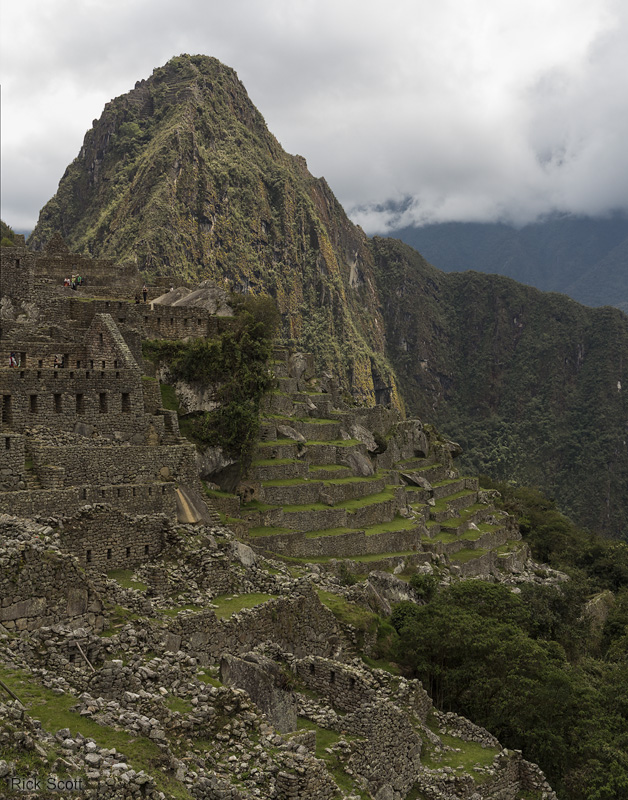
In the residential section of Machu Picchu showing Wayna Picchu and erosion control terraces.
Lens: Internal 15.1-60.4 mm, set to 25.4mm
Exposure: 1/100 second at f/8
Camera Mode: ISO 100 RAW
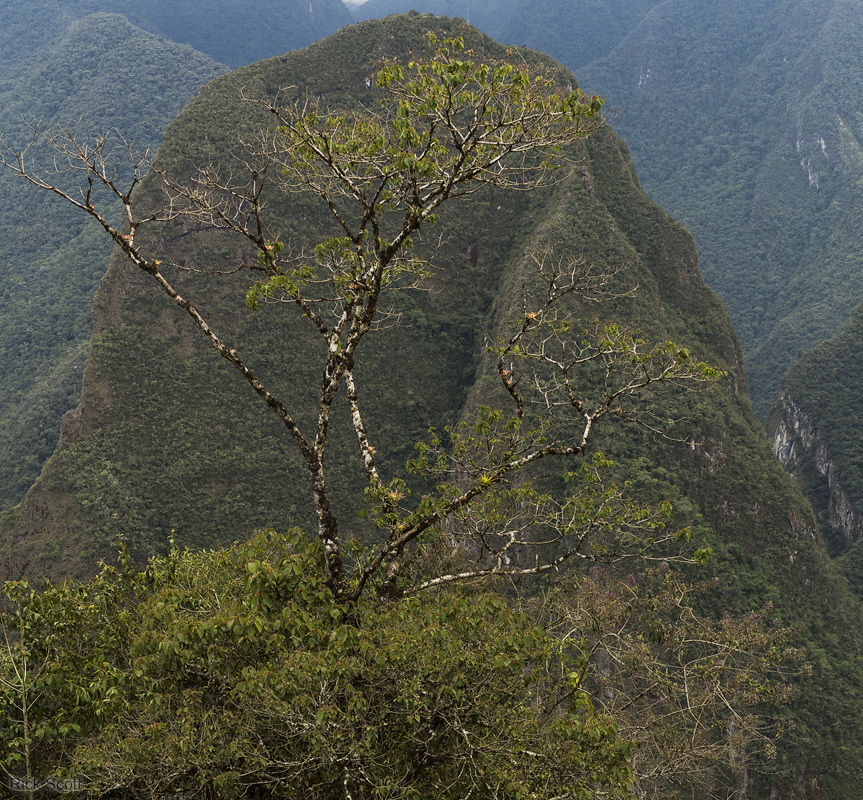
Tree and peak at Machu Picchu.
Lens: Internal 15.1-60.4 mm, set to 30.9mm
Exposure: 1/50 second at f/8
Camera Mode: ISO 100 RAW
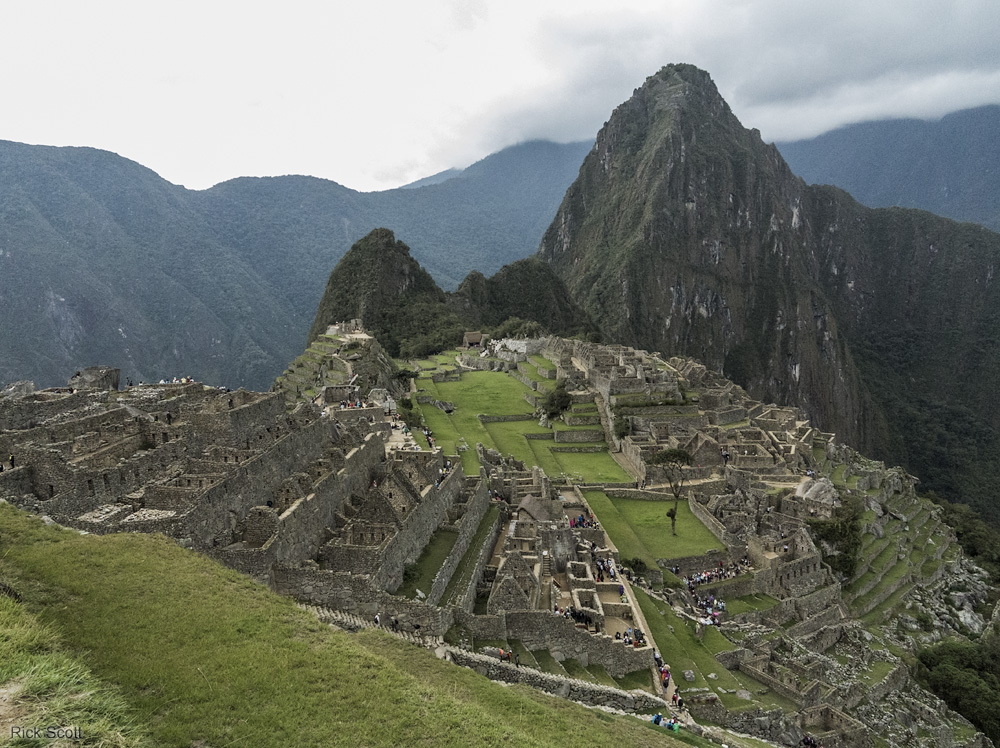
The "classic" view of Machu Picchu. The religious section is on the left and the residential is on the right with Wayna Picchu in the background.
Lens: Internal 15.1-60.4 mm, set to 15.1mm
Exposure: 1/1600 second at f/8
Camera Mode: ISO 3200 RAW
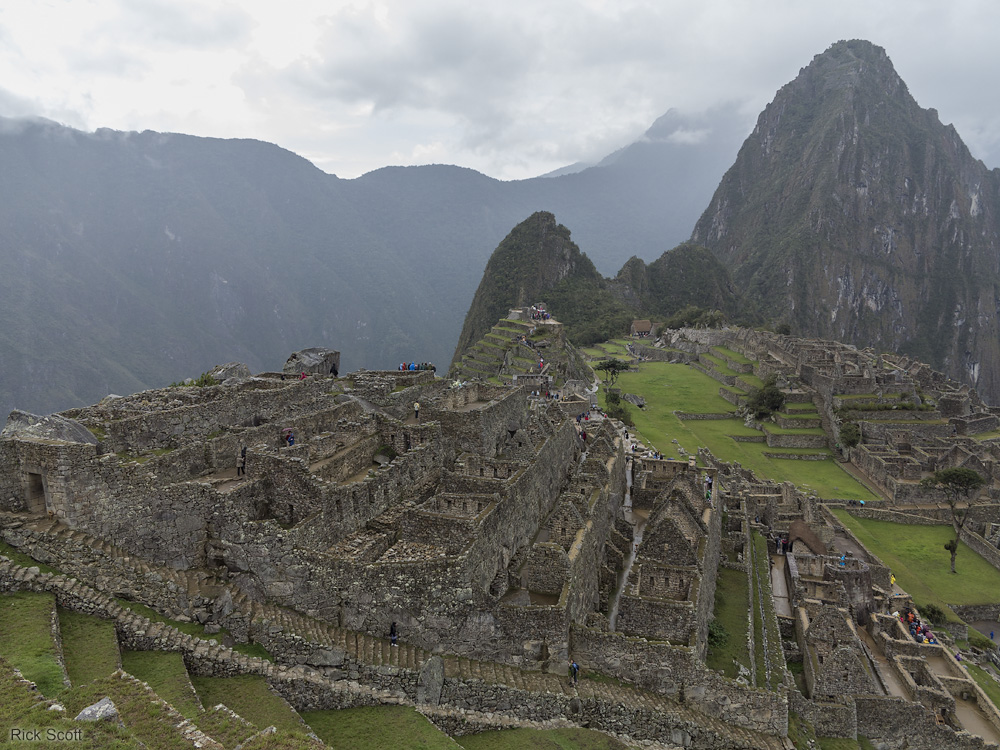
A different version of the "classic" view of Machu Picchu. This view shows the main entrance from the Inca Trail into the religious section (far left).
The stairs in the foreground lead from the Inca Trail to the residential section. It was raining when I took this photograph.
Lens: Internal 15.1-60.4 mm, set to 15.1mm
Exposure: 1/80 second at f/8
Camera Mode: ISO 100 RAW
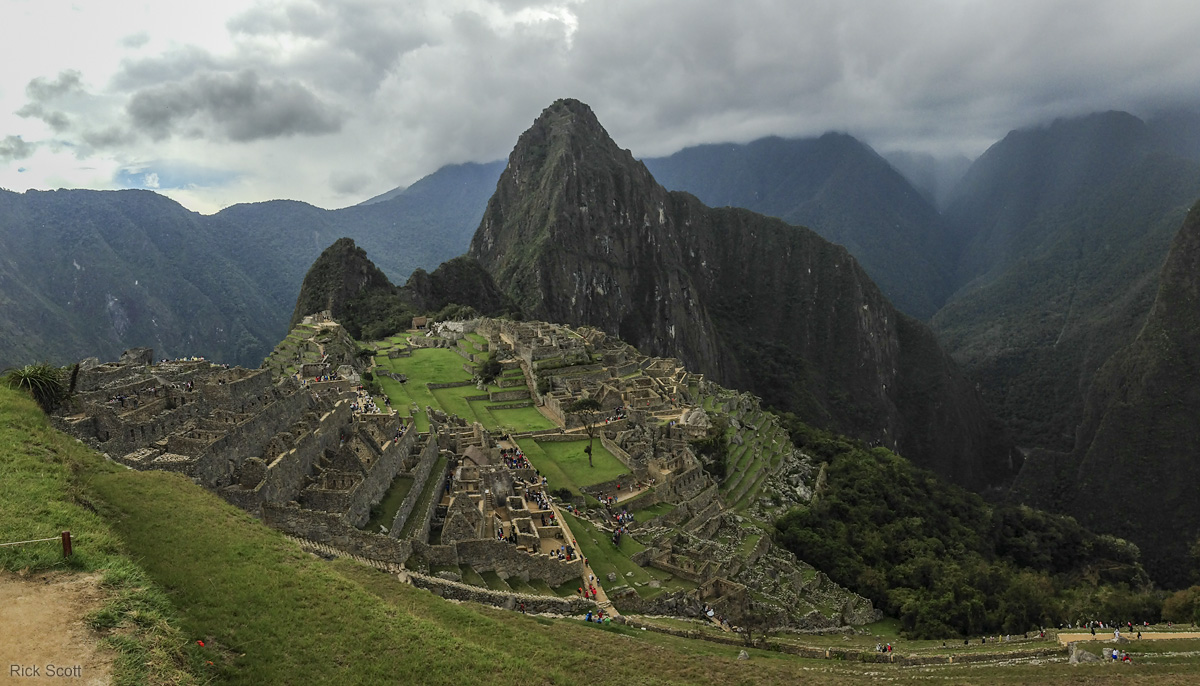
An iPhone panorama of the "classic" view of Machu Picchu.
This panorama is wide enough to show Wayna Picchu
as the nose of a face in profile looking up at the sky
(forehead rolling off to the right and a protruding chin on the left).
Camera: iPhone 5
Lens: Internal 4.12mm
Exposure: 1/1600 second at f/2.4
Camera Mode: Panorama
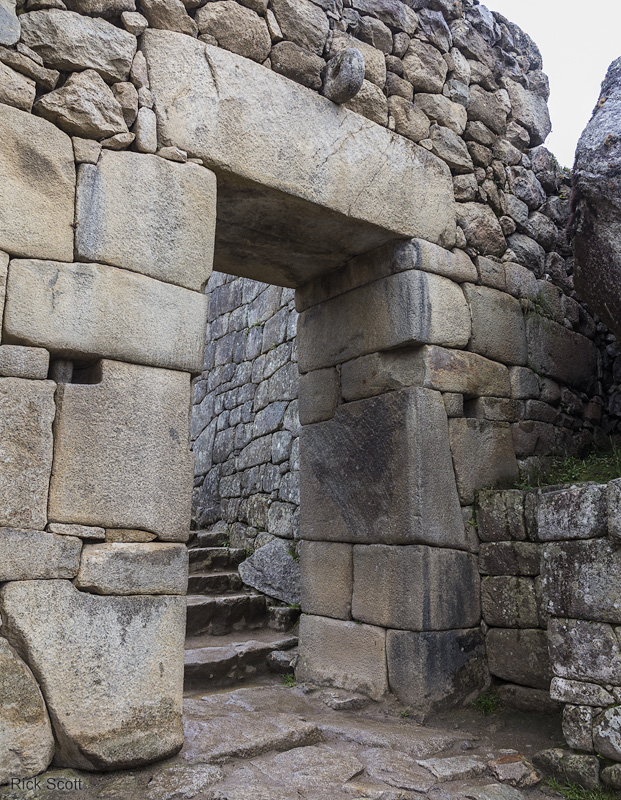
The main entrance gate to the religious section of Machu Picchu from the inside.
The rock loop over the doorway and the niches with pins on both
sides are part of the mechanism of the door that blocked passage.
Lens: Internal 15.1-60.4 mm, set to 16.8mm
Exposure: 1/125 second at f/4.5
Camera Mode: ISO 100 RAW
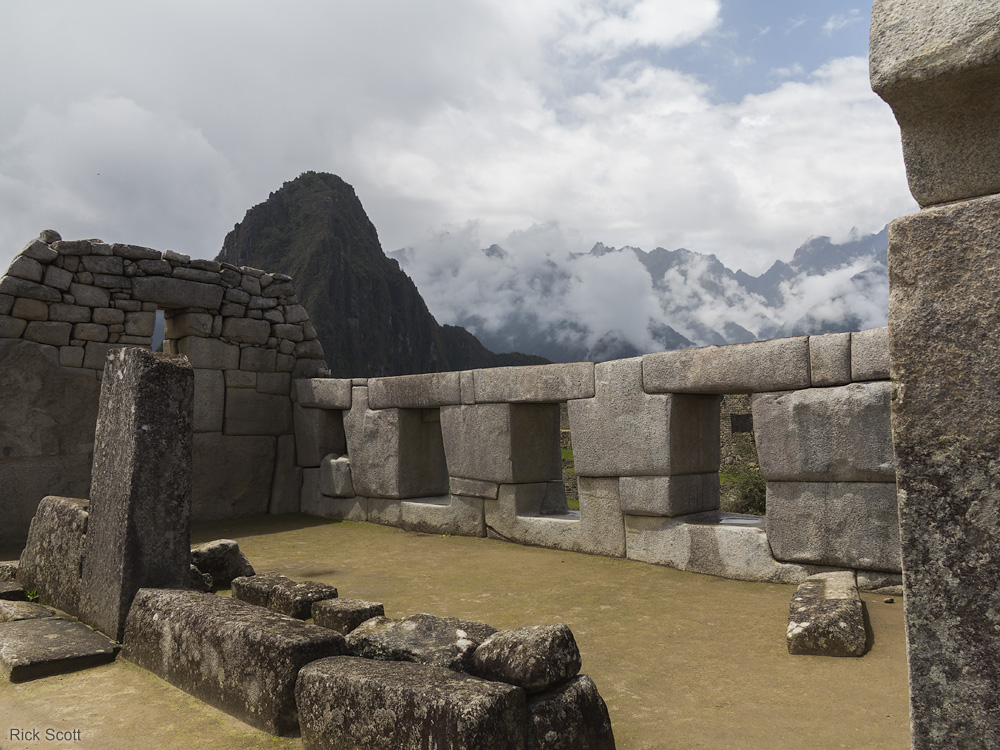
Temple of the Three Windows in the religious section of Machu Picchu.
Lens: Internal 15.1-60.4 mm, set to 15.1mm
Exposure: 1/500 second at f/4.5
Camera Mode: ISO 100 RAW
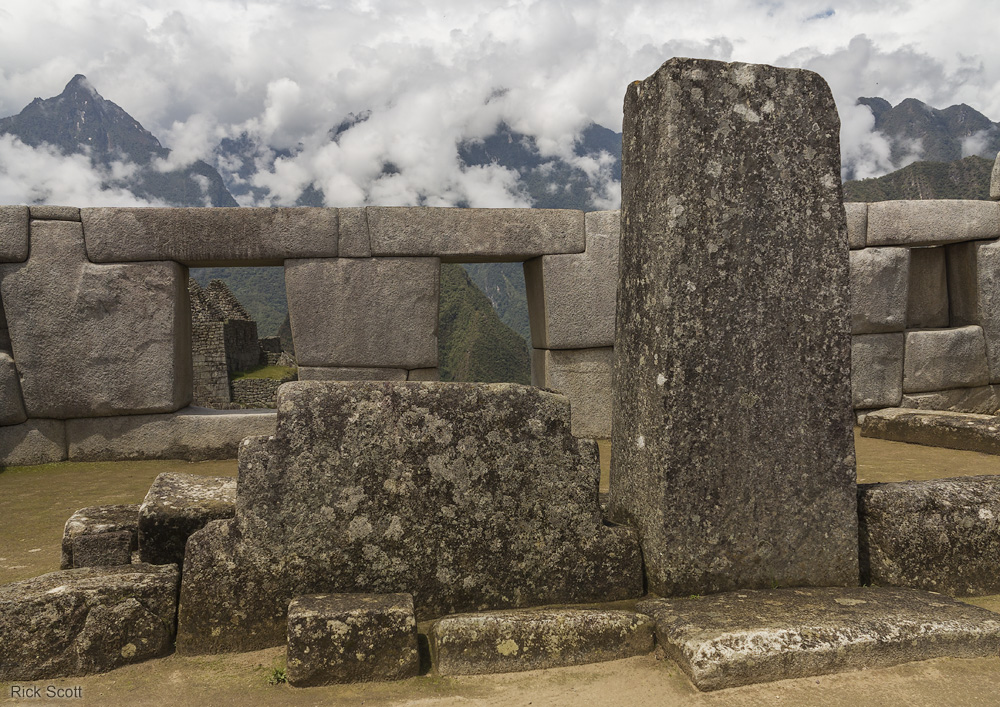
The Temple of the Three Windows at Machu Picchu.
One function of this temple was to determine when the equinox occurred.
The large stone to the left of the column is the top half of a Chakana,
the Inca cross. During the equinox, it's shadow forms the lower half.
Lens: Internal 15.1-60.4 mm, set to 17.5mm
Exposure: 1/400 second at f/8
Camera Mode: ISO 100 RAW
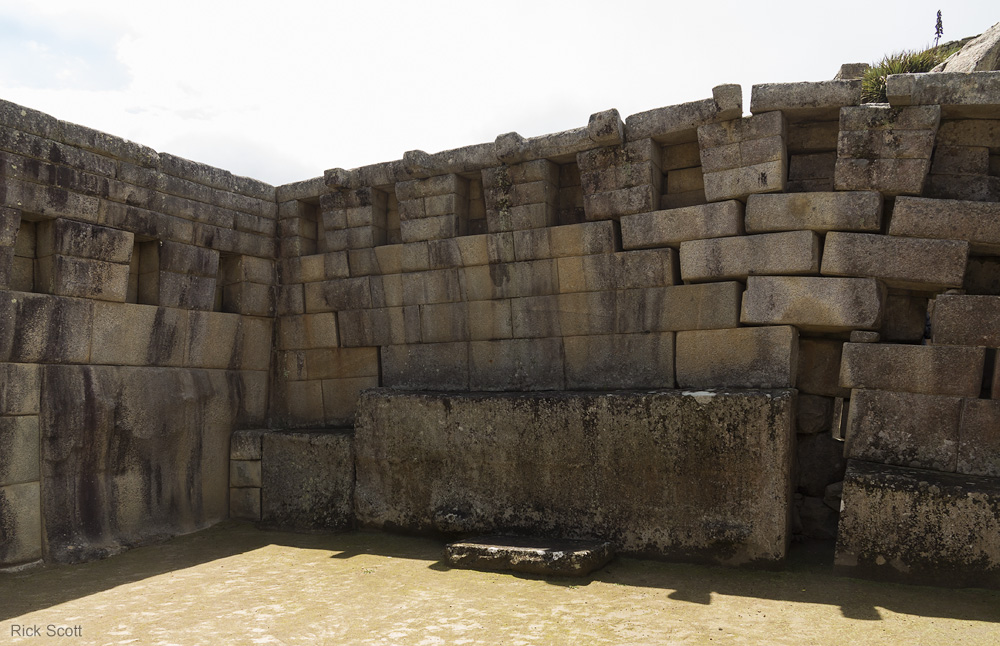
The Principal Temple with altar at Machu Picchu, Peru. The wall on the right is being affected by ground settling.
Lens: Internal 15.1-60.4 mm, set to 15.1mm
Exposure: 1/100 second at f/8
Camera Mode: ISO 100 RAW
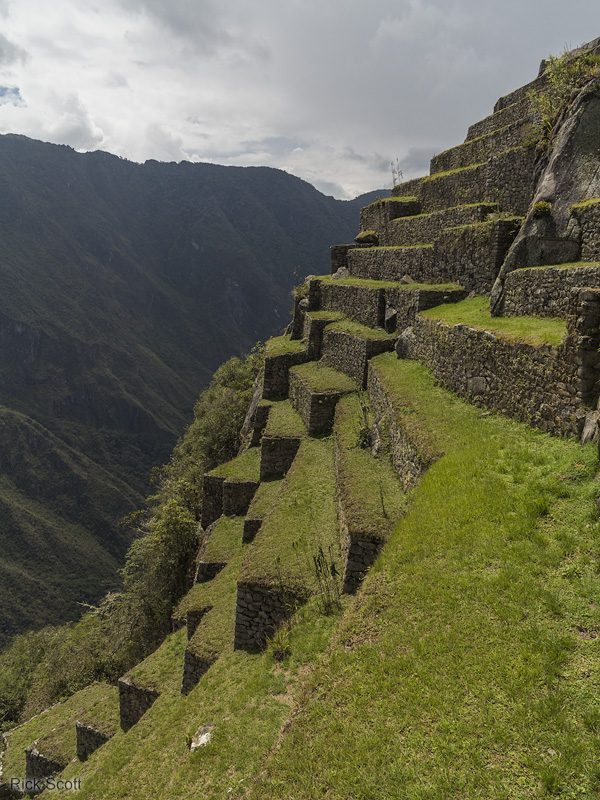
These narrow terraces are for erosion control below the summit of the Intihuatana at Machu Picchu.
Lens: Internal 15.1-60.4 mm, set to 15.1mm
Exposure: 1/320 second at f/8
Camera Mode: ISO 100 RAW
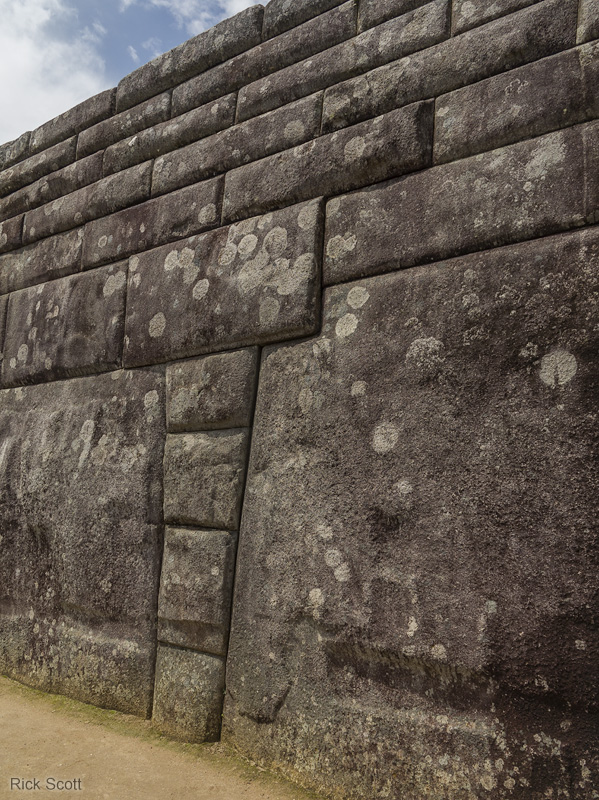
The "T" in the western wall of the Principal Temple at Machu Picchu.
Lens: Internal 15.1-60.4 mm, set to 15.1mm
Exposure: 1/250 second at f/8
Camera Mode: ISO 100 RAW
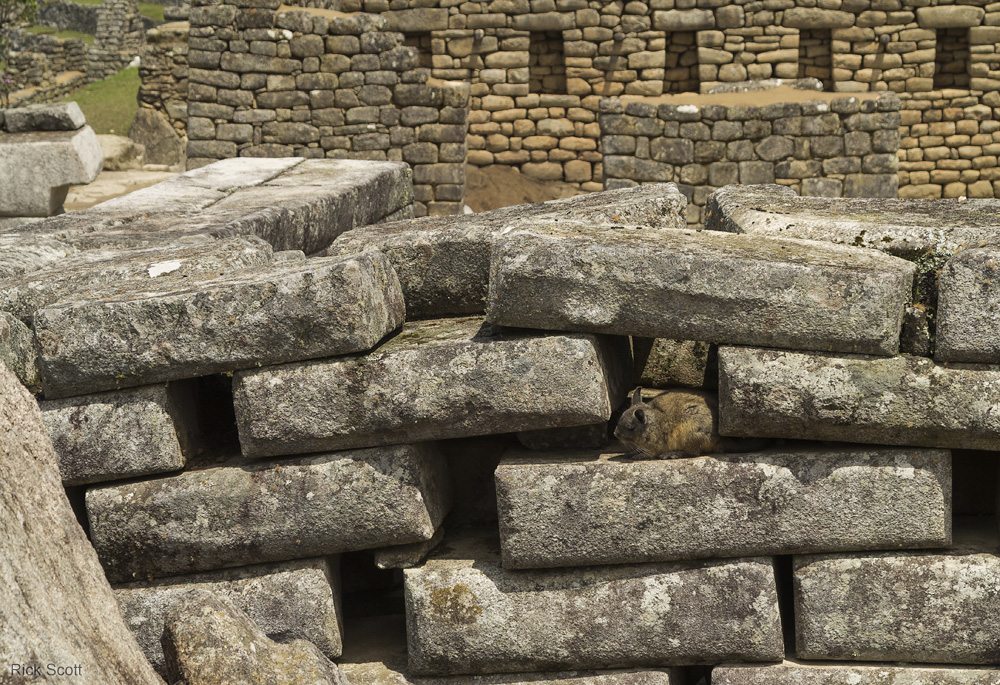
This chinchilla found a home in the northern wall of the Principal Temple at Machu Picchu.
Lens: Internal 15.1-60.4 mm, set to 60.4mm
Exposure: 1/320 second at f/8
Camera Mode: ISO 100 RAW
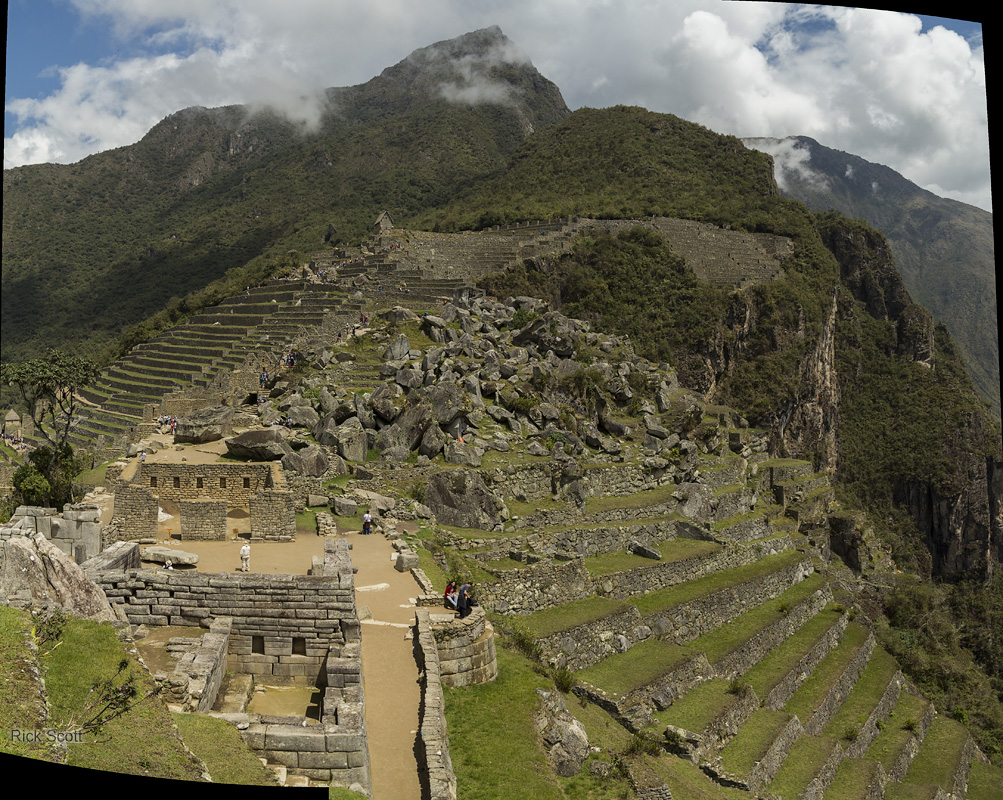
Looking down on the religious section of Machu Picchu from the trail up to the Intihuatana. This is a two-shot panorama.
Lens: Internal 15.1-60.4 mm, set to 15.1mm
Exposure: 1/320 second at f/8
Camera Mode: ISO 100 RAW
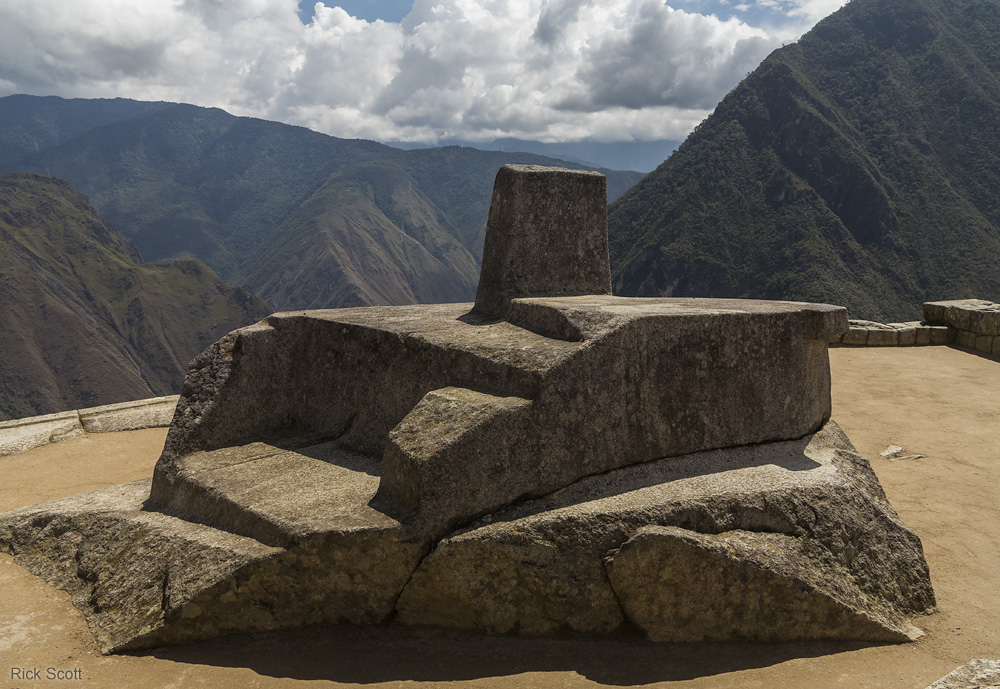
The Intihuatana at Machu Picchu, Peru. This is the "Hitching Post of the Sun",
most likely used to determine the seasons from it's shadow. These were very
common in the Inca world. The Spanish destroyed all of them except this one
because they didn't find Machu Picchu.
Lens: Internal 15.1-60.4 mm, set to 15.1mm
Exposure: 1/500 second at f/8
Camera Mode: ISO 100 RAW
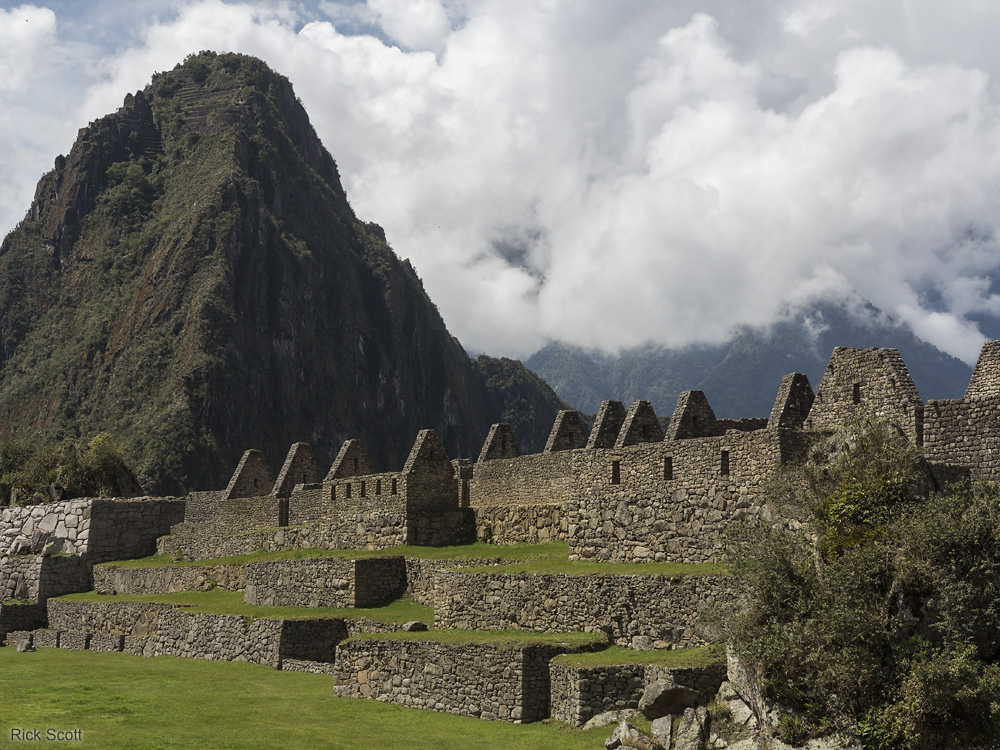
The residential section of Machu Picchu in afternoon light with Wayna Picchu in the background.
The terraces near the top of Wayna Picchu can be seen in this photograph.
Lens: Internal 15.1-60.4 mm, set to 31.4mm
Exposure: 1/320 second at f/8
Camera Mode: ISO 100 RAW
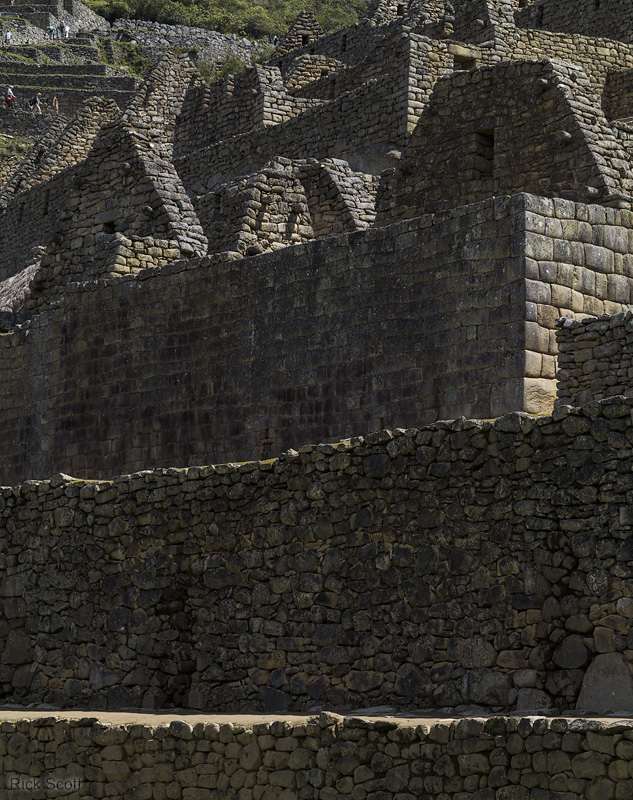
The religious section of Machu Picchu.
Lens: Internal 15.1-60.4 mm, set to 60.4mm
Exposure: 1/320 second at f/8
Camera Mode: ISO 100 RAW
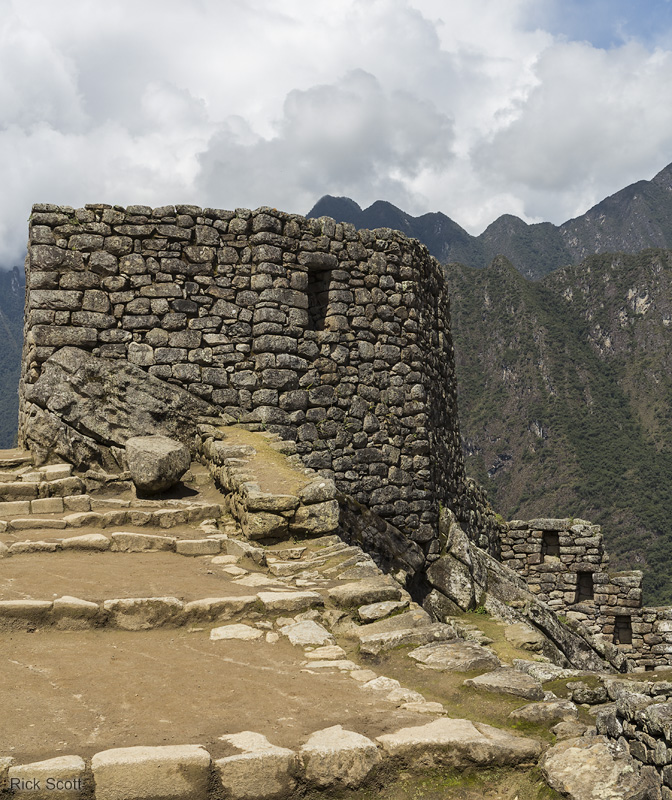
In the religious section of Machu Picchu.
Lens: Internal 15.1-60.4 mm, set to 24.5mm
Exposure: 1/320 second at f/8
Camera Mode: ISO 100 RAW
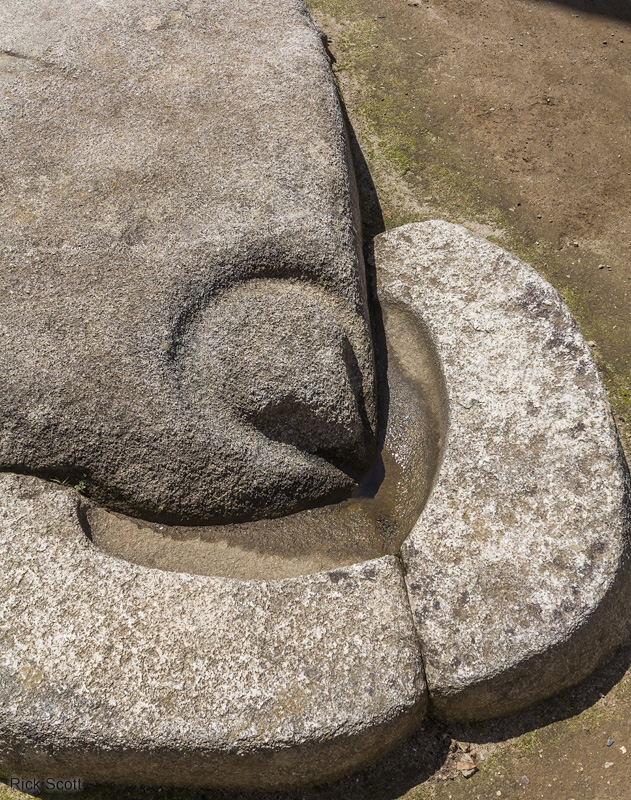
The head of the condor in the Temple of the Condor at Machu Picchu.
Lens: Internal 15.1-60.4 mm, set to 21.7mm
Exposure: 1/320 second at f/8
Camera Mode: ISO 100 RAW
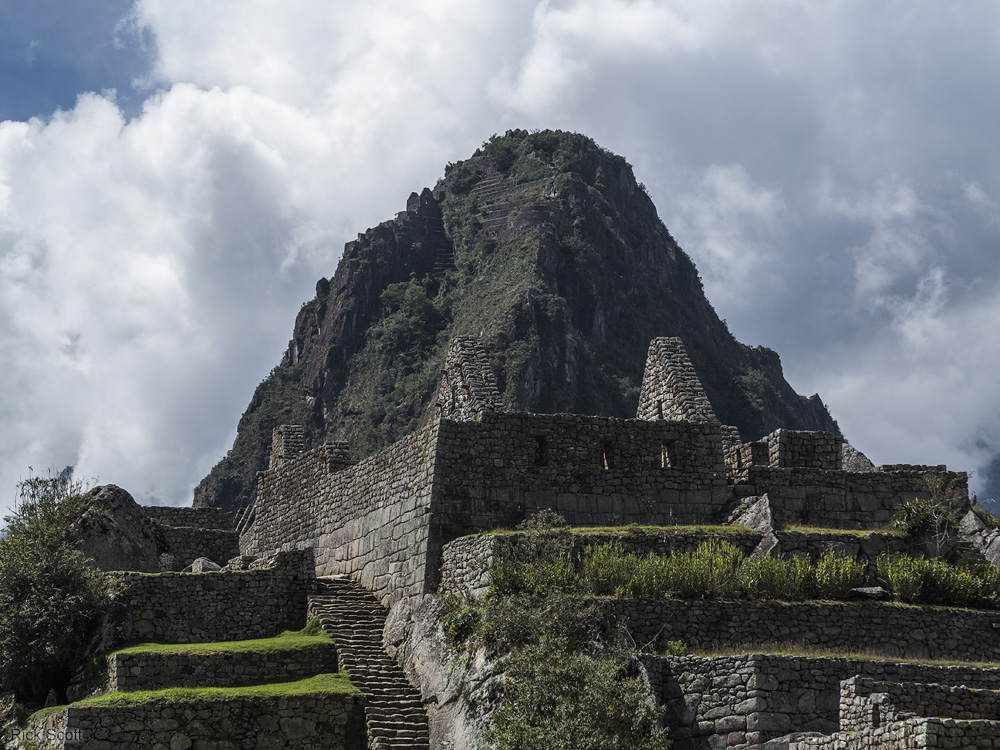
The residential section of Machu Picchu in afternoon light with Wayna Picchu in the background.
The terraces near the top of Wayna Picchu can be seen in this photograph.
Lens: Internal 15.1-60.4 mm, set to 44.6mm
Exposure: 1/400 second at f/8
Camera Mode: ISO 100 RAW
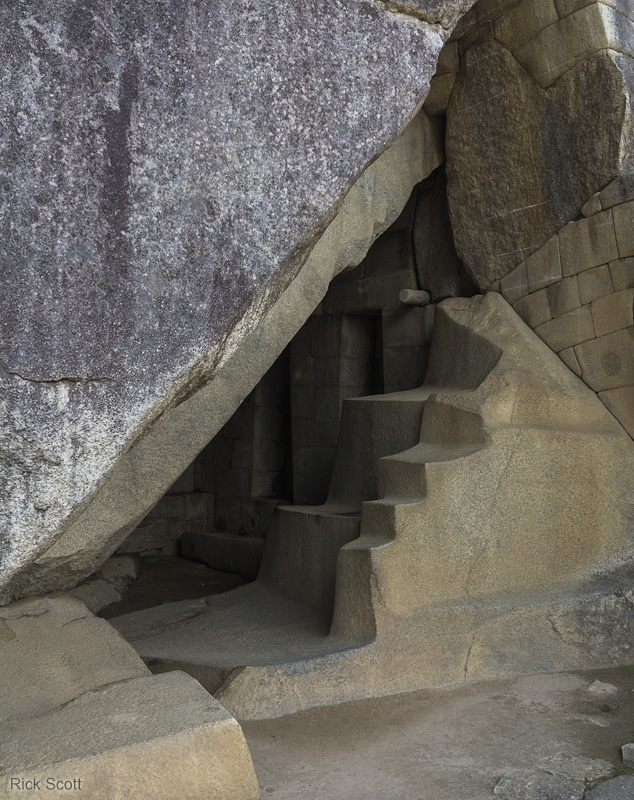
The inner chamber of the Temple to Pachamama (Earth Goddess) at Machu Picchu.
Lens: Internal 15.1-60.4 mm, set to 19.9mm
Exposure: 1/160 second at f/8
Camera Mode: ISO 400 RAW
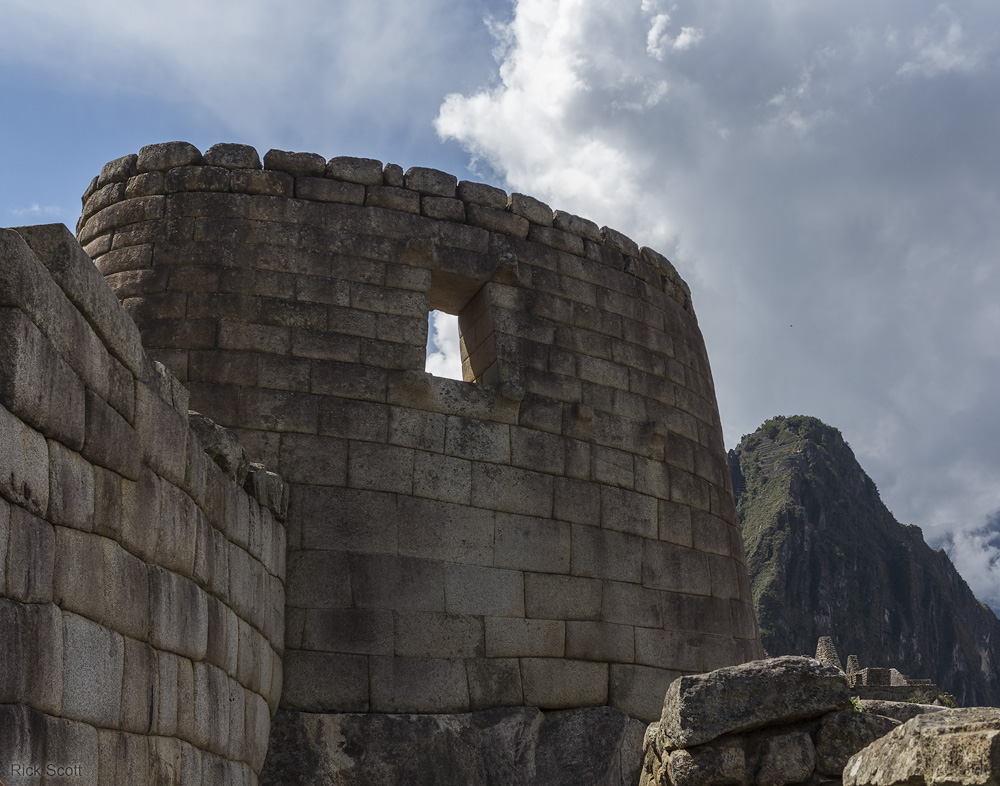
The Torreon (Temple of the Sun) on top of the Temple to Pachamama at Machu Picchu.
It functioned as an astronomical observatory.
Lens: Internal 15.1-60.4 mm, set to 22.5mm
Exposure: 1/320 second at f/8
Camera Mode: ISO 100 RAW
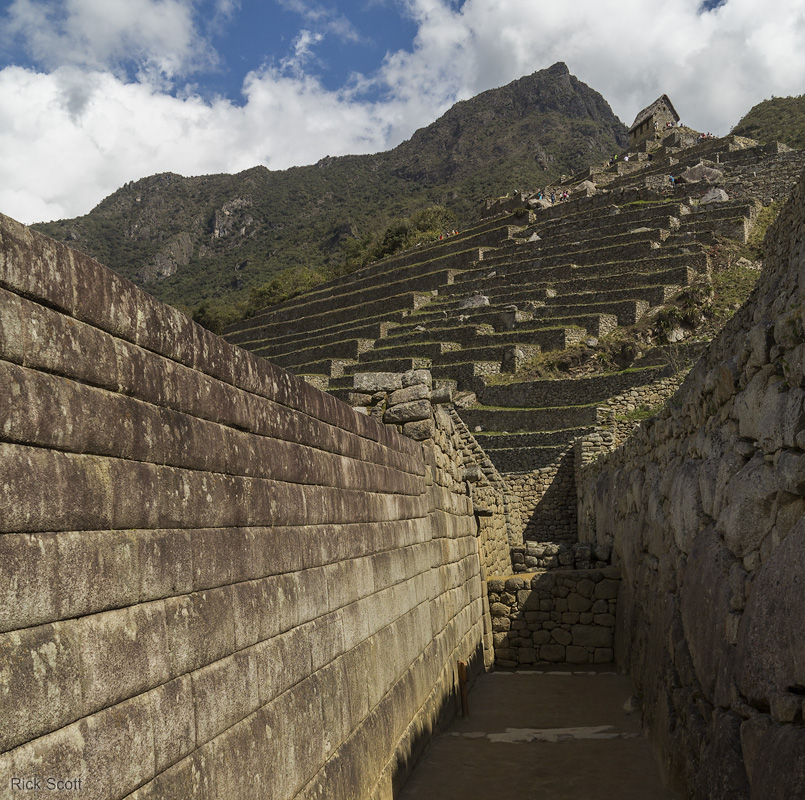
Picchu Mountain, the Gatehouse, and agricultural terraces at Machu Picchu.
It functioned as an astronomical observatory.
Lens: Internal 15.1-60.4 mm, set to 15.1mm
Exposure: 1/320 second at f/8
Camera Mode: ISO 100 RAW